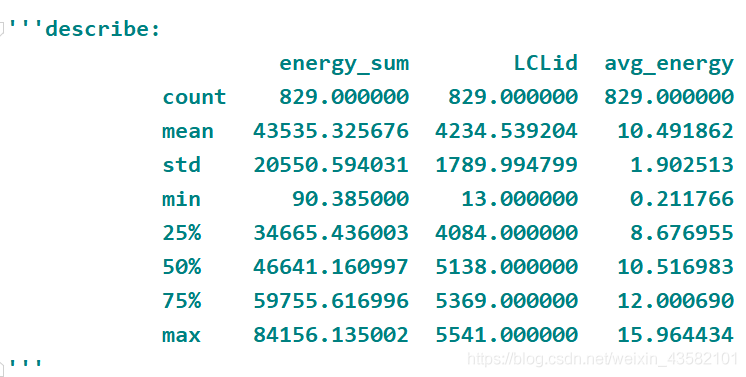
To better follow the energy consumption, the government wants energy suppliers to install smart meters in every home in England, Wales and Scotland. There are more than 26 million homes for the energy suppliers to get to, with the goal of every home having a smart meter by 2020.
This roll out of meter is lead by the European Union who asked all member governments to look at smart meters as part of measures to upgrade our energy supply and tackle climate change. After an initial study, the British government decided to adopt smart meters as part of their plan to update our ageing energy system.
In this dataset, you will find a refactorised version of the data from the London data store, that contains the energy consumption readings for a sample of 5,567 London Households that took part in the UK Power Networks led Low Carbon London project between November 2011 and February 2014. The data from the smart meters seems associated only to the electrical consumption.
目标: 综合考虑气候、时间、季节、节日以及需求响应等因素,实现负荷预测功能。
数据源: https://www.kaggle.com/jeanmidev/smart-meters-in-london
处理流程:
- 将所有数据进行合并
- 根据每户每天的能源消耗数据,对不一致的住户统计数据进行规范化处理
- 探索天气状况等因素和能源消耗之间的关系
- 将英国假日数据添加到日水平数据中作为指标
- 拟合SARIMAX模型
- 拟合LSTM模型
目录结构:

环境:
Keras==2.0.2
TensorFlow==1.15.5
scikit-learn==0.24.1
数据整合
def first():
for num in range(0,112):
df = pd.read_csv("data/daily_dataset/block_"+str(num)+".csv")
df = df[['day','LCLid','energy_sum']]
df.reset_index()
df.to_csv("data/hc/hc_"+str(num)+".csv")
fout= open("data/energy.csv","a")
for line in open("data/hc/hc_0.csv"):
fout.write(line)
for num in range(0,112):
f = open("data/hc/hc_"+str(num)+".csv")
f.readline()
for line in f:
fout.write(line)
f.close()
fout.close()
first()
各个家庭的数据收集是不同的,因此我们将使用“每个家庭的能源”作为预测的目标,而不是仅仅使用能源。
然而有相当多的独特的家庭,所以需要多次出来,我们的最终目标是预测整体消费预测,而不是在家庭水平。
energy = pd.read_csv('data/energy.csv')
housecount = energy.groupby('day')[['LCLid']].nunique()
energy = energy.groupby('day')[['energy_sum']].sum()
energy = energy.merge(housecount, on = ['day'])
energy = energy.reset_index()
energy.count()
energy.day = pd.to_datetime(energy.day,format='%Y-%m-%d').dt.date
energy['avg_energy'] = energy['energy_sum']/energy['LCLid']

天气信息
weather = pd.read_csv('data/weather_daily_darksky.csv')
print(weather.head(4))

weather['day']= pd.to_datetime(weather['time'])
weather['day']= pd.to_datetime(weather['day'],format='%Y%m%d').dt.date
weather = weather[['temperatureMax', 'windBearing', 'dewPoint', 'cloudCover', 'windSpeed',
'pressure', 'apparentTemperatureHigh', 'visibility', 'humidity',
'apparentTemperatureLow', 'apparentTemperatureMax', 'uvIndex',
'temperatureLow', 'temperatureMin', 'temperatureHigh',
'apparentTemperatureMin', 'moonPhase','day']]
weather = weather.dropna()
weather_energy = energy.merge(weather,on='day')

plt.rcParams['font.sans-serif'] = ['SimHei']
plt.rcParams['axes.unicode_minus'] = False
def drow1():
fig, ax1 = plt.subplots(figsize = (20,5))
ax1.plot(weather_energy.day, weather_energy.temperatureMax, color = 'tab:orange')
ax1.plot(weather_energy.day, weather_energy.temperatureMin, color = 'tab:pink')
ax1.set_ylabel('Temperature')
ax1.legend()
ax2 = ax1.twinx()
ax2.plot(weather_energy.day,weather_energy.avg_energy,color = 'tab:blue')
ax2.set_ylabel('Average Energy/Household',color = 'tab:blue')
ax2.legend(bbox_to_anchor=(0.0, 1.02, 1.0, 0.102))
plt.title('能耗和温度')
fig.tight_layout()
plt.show()

def drow2():
fig, ax1 = plt.subplots(figsize = (20,5))
ax1.plot(weather_energy.day, weather_energy.humidity, color = 'tab:orange')
ax1.set_ylabel('Humidity',color = 'tab:orange')
ax2 = ax1.twinx()
ax2.plot(weather_energy.day,weather_energy.avg_energy,color = 'tab:blue')
ax2.set_ylabel('Average Energy/Household',color = 'tab:blue')
plt.title('能耗和湿度')
fig.tight_layout()
plt.show()

def drow3():
fig, ax1 = plt.subplots(figsize = (20,5))
ax1.plot(weather_energy.day, weather_energy.cloudCover, color = 'tab:orange')
ax1.set_ylabel('Cloud Cover',color = 'tab:orange')
ax2 = ax1.twinx()
ax2.plot(weather_energy.day,weather_energy.avg_energy,color = 'tab:blue')
ax2.set_ylabel('Average Energy/Household',color = 'tab:blue')
plt.title('Energy Consumption and Cloud Cover')
fig.tight_layout()
plt.show()

def drow4():
fig, ax1 = plt.subplots(figsize = (20,5))
ax1.plot(weather_energy.day, weather_energy.visibility, color = 'tab:orange')
ax1.set_ylabel('Visibility',color = 'tab:orange')
ax2 = ax1.twinx()
ax2.plot(weather_energy.day,weather_energy.avg_energy,color = 'tab:blue')
ax2.set_ylabel('Average Energy/Household',color = 'tab:blue')
plt.title('Energy Consumption and Visibility')
fig.tight_layout()
plt.show()

def drow5():
fig, ax1 = plt.subplots(figsize = (20,5))
ax1.plot(weather_energy










